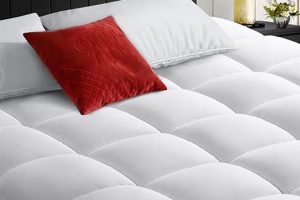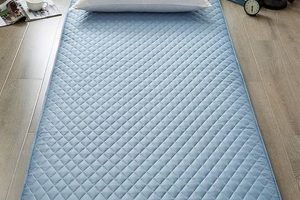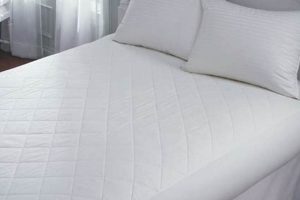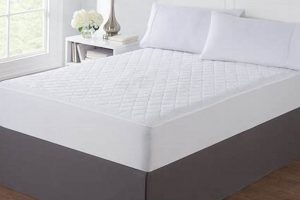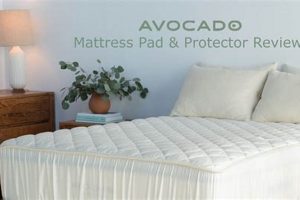A cushioned layer designed to enhance the sleep surface, providing added comfort and protection for the underlying mattress. These items typically feature fitted sheets or anchor bands to secure them to the mattress, preventing slippage and ensuring a snug fit. They are often constructed from materials like cotton, memory foam, or down alternatives, each offering varying levels of support and temperature regulation. For instance, a quilted cotton version might offer breathability, while a memory foam version emphasizes pressure relief.
The utilization of such an item extends the lifespan of a mattress by shielding it from spills, stains, and wear. This can represent a significant cost saving over time. Furthermore, the enhanced comfort level contributes to improved sleep quality, potentially reducing tossing and turning throughout the night. Historically, simpler mattress protectors existed primarily to prevent soiling. Modern versions, however, are engineered for improved hygiene, comfort, and mattress preservation.
The following sections will delve into specific features, material compositions, cleaning guidelines, and comparative analysis of different types, enabling a more informed purchasing decision based on individual needs and preferences. Considerations will include factors such as allergy sensitivity, desired firmness, and thermal regulation capabilities.
Tips Regarding Mattress Enhancements
The following recommendations are designed to maximize the benefits and lifespan of mattress enhancements, ensuring optimal sleep quality and hygiene.
Tip 1: Proper Size Selection: Ensure the chosen size precisely matches the dimensions of the mattress. An ill-fitting cover can bunch, slip, or fail to provide adequate protection. Measure the mattress accurately before purchase.
Tip 2: Material Consideration Based on Needs: Select the material based on individual preferences and requirements. Individuals with allergies should opt for hypoallergenic materials. Those seeking pressure relief may benefit from memory foam options, while hot sleepers may prefer breathable cotton or bamboo.
Tip 3: Regular Cleaning: Adhere to the manufacturer’s cleaning instructions. Routine washing, typically monthly or quarterly depending on usage, helps maintain hygiene and prevent allergen buildup. Ignoring this step can compromise its protective and comfort-enhancing properties.
Tip 4: Waterproof Protection for Enhanced Durability: Consider waterproof or water-resistant options, especially for households with children or pets. This prevents liquids from penetrating the mattress, mitigating staining and potential mold growth. Check the level of waterproof and make sure it is safe materials.
Tip 5: Secure Attachment Methods: Examine the attachment mechanism, such as fitted sheets, elastic straps, or anchor bands. Prioritize those that offer a secure fit to prevent shifting during sleep. Loose or inadequate attachment can diminish its functionality.
Tip 6: Avoid Harsh Chemicals During Cleaning: When cleaning, refrain from using harsh chemicals or bleach, as these can degrade the materials and potentially release harmful fumes. Opt for gentle detergents specifically designed for bedding.
Tip 7: Assess Thread Count (If Applicable): If the option is made of fabric, consider the thread count. A higher thread count generally indicates a softer and more durable fabric, contributing to increased comfort and longevity. Check the product specification before buying.
Following these guidelines contributes to a cleaner, more comfortable sleep environment and preserves the integrity of both the mattress and the add-on itself. Prioritizing these practices extends the lifespan and overall value of the investment.
The following sections will detail specific use cases and common issues, providing a more in-depth understanding of optimal utilization and maintenance.
1. Comfort enhancement
The relationship between enhanced comfort and a mattress overlay is central to its function and perceived value. The selection of specific materials and designs directly impacts the degree of enhanced comfort afforded. For example, a memory foam version molds to the body, distributing weight and alleviating pressure points. This, in turn, can reduce tossing and turning during sleep, leading to a more restful experience. Conversely, an improperly chosen type, constructed from low-quality materials or lacking sufficient padding, may fail to provide adequate comfort, negating its intended benefit.
Enhanced comfort is not merely a subjective preference; it has tangible consequences for sleep quality and overall well-being. Individuals experiencing chronic back pain, for instance, may find significant relief from a strategically designed enhancement that provides targeted support. Similarly, those prone to overheating during sleep may benefit from a breathable option that promotes airflow and regulates temperature. The practical application of this understanding lies in tailoring the selection to individual needs and physical conditions. Choosing a product with the appropriate thickness, density, and material composition is crucial for achieving the desired level of comfort.
In summary, enhanced comfort is a primary objective and a critical performance indicator. Challenges arise in accurately assessing individual comfort preferences and matching them to the diverse range of products available. Understanding the interplay between material properties, design features, and individual needs is essential for maximizing the comfort benefits. The achievement of significant comfort improvement represents a core element in the overall effectiveness and satisfaction with a mattress pad.
2. Mattress protection
The primary function of a mattress enhancement is to safeguard the underlying mattress from various forms of degradation. Spills, stains, allergens, dust mites, and general wear and tear can significantly reduce the lifespan and hygiene of a mattress. Effective mattress protection mitigates these risks, preserving the integrity and comfort of the mattress over time. A well-designed barrier prevents liquids from penetrating the mattress core, inhibiting mold growth and maintaining a cleaner sleep surface. For example, a polyurethane-backed version is highly effective at blocking liquids, thus preventing internal damage and unsanitary conditions.
The importance of mattress protection extends beyond mere cleanliness. It directly impacts the warranty validity of many mattresses, which often exclude coverage for damage resulting from spills or stains. Furthermore, a protected mattress maintains its structural integrity, providing consistent support and reducing the likelihood of sagging or unevenness. Consider the scenario of a household with young children prone to accidents; the presence of a robust, waterproof pad can
prevent costly mattress replacements. Similarly, individuals with allergies benefit from a barrier that minimizes dust mite accumulation, reducing allergic reactions and promoting healthier sleep.
In summary, the inclusion of effective mattress protection as a core feature is critical. Addressing the challenges associated with balancing protection and comfort is key to developing optimized solutions. The degree of protection offered and the type of materials used must be aligned with the anticipated usage conditions and the needs of the end-user. The practical significance lies in extending the lifespan of the mattress and maintaining a hygienic sleep environment, thus enhancing overall value and well-being.
3. Material composition
The attributes of any mattress enhancement are inextricably linked to its material composition. The choice of materials directly influences the pad’s comfort, durability, breathability, and protective qualities. Natural fibers, such as cotton or wool, often provide superior breathability and moisture-wicking capabilities, whereas synthetic materials, like polyester or memory foam, may offer enhanced durability and pressure relief. The specific blend of materials determines the overall performance characteristics. For example, a pad featuring a high thread count cotton cover combined with a hypoallergenic fill provides a comfortable and allergy-friendly sleep surface, whereas a version employing a waterproof polyurethane layer offers superior protection against liquid spills. The practical significance of this understanding lies in selecting a pad that aligns with individual needs and preferences, considering factors such as allergies, temperature sensitivity, and desired level of protection.
Beyond the primary materials, the construction techniques and secondary components also play a crucial role. Quilted designs distribute the fill evenly, preventing clumping and maintaining consistent loft. Elastic straps or fitted skirts ensure a secure fit to the mattress, preventing slippage and bunching during sleep. The use of OEKO-TEX certified fabrics guarantees that the materials are free from harmful substances, promoting a healthier sleep environment. Understanding these nuances allows for a more informed purchasing decision, enabling consumers to prioritize specific features and benefits based on their unique requirements. Consider the scenario of an individual with sensitive skin; the selection of a pad made from organic cotton and free from dyes or chemical treatments is paramount.
In summary, material composition serves as the foundational determinant of a mattress enhancement’s performance and suitability. Challenges arise in accurately assessing the long-term durability and comfort characteristics of different material combinations. The implications are that detailed product specifications are essential for informed consumer choices. Ultimately, careful consideration of material composition is vital for maximizing the comfort, hygiene, and longevity of the sleep experience. This knowledge allows consumers to align their purchase with their specific needs and preferences.
4. Secure fit
The term “secure fit,” in the context of a mattress enhancement, refers to the ability of the pad to remain firmly in place on the mattress during use. This characteristic is paramount to its functionality and intended benefits. A pad that shifts or bunches disrupts the sleep surface, negating any comfort or protective qualities it is meant to provide. The mechanisms ensuring a secure fit commonly include elastic straps, fitted skirts, or anchor bands designed to grip the mattress edges. Failure to maintain a secure fit can lead to uneven weight distribution, increased pressure points, and potential damage to both the pad and the mattress itself. Consider, for example, an individual experiencing nightly discomfort due to a pad constantly shifting beneath them. The lack of a secure fit directly undermines the intended purpose of the item.
The importance of a secure fit extends beyond mere comfort. A shifting pad can compromise its protective function, exposing the mattress to spills, stains, and allergens. This is particularly relevant in households with children or pets, where the risk of accidents is higher. Furthermore, constant readjustment of a dislodged pad can disrupt sleep and contribute to frustration. The selection of a design with robust attachment mechanisms is, therefore, essential. Examples of effective designs include deep-pocket fitted skirts that accommodate thicker mattresses, and adjustable elastic straps that can be tightened to achieve a snug fit. The practical application of this understanding lies in carefully evaluating the attachment system of any pad under consideration, ensuring it is compatible with the mattress dimensions and capable of withstanding regular movement.
In summary, “secure fit” is a critical performance attribute that directly impacts the effectiveness and user satisfaction with a mattress enhancement. Addressing challenges associated with maintaining a secure fit across different mattress types and usage conditions is key to optimized designs. The implications are that robust attachment mechanisms and proper size selection are essential for achieving the intended benefits. Ultimately, prioritizing a secure fit contributes to a more comfortable, hygienic, and durable sleep environment, enhancing the overall value and longevity of the investment. This ensures consistent performance and prevents the need for frequent readjustments, promoting undisturbed sleep.
5. Ease of care
The attribute “Ease of care” is intrinsically linked to the long-term value and functionality of any mattress enhancement. A cleaning regime that is overly complex or time-consuming will likely be neglected, leading to a buildup of allergens, stains, and odors. This, in turn, compromises the hygienic benefits the item is intended to provide and reduces its lifespan. A product marketed as offering enhanced comfort and protection must also be reasonably easy to maintain to realize its full potential. For example, a pad requiring professional dry cleaning will be less appealing to consumers than one that can be machine washed and dried at home. Neglecting proper cleaning, regardless of the cause, allows the proliferation of dust mites and bacteria within the sleep environment, potentially triggering allergic reactions and respiratory issues.
The practical significance of “Ease of care” manifests in several ways. The inclusion of clear, concise cleaning instructions from the manufacturer is essential. These instructions should specify appropriate washing temperatures, detergent types, and drying methods to avoid damaging the materials or compromising the protective layers. Moreover, the materials used in the pad’s construction directly influence its ease of care. A pad constructed from stain-resistant fabrics will require less frequent washing and will be more forgiving of minor spills. Similarly, a design that incorporates a removable, washable cover simplifies the cleaning process and extends the lifespan of the fill material. Consumers might opt for versions with antimicrobial treatments that inhibit bacterial growth and reduce the need for frequent cleaning.
In summary, “Ease of care” is a crucial facto
r influencing the long-term utility and hygiene of any mattress topper. A challenge lies in balancing durability and comfort with simplified cleaning requirements. It provides convenience and peace of mind. Ultimately, prioritizing this contributes to a cleaner, healthier sleep environment and enhances the overall value of the investment. The connection is simple – a product easy to care for is more likely to be cared for and will deliver the benefits it promises for a longer period.
Frequently Asked Questions about Mattress Enhancements
This section addresses common inquiries regarding the functionality, selection, and maintenance of mattress enhancements, providing clear and concise answers to assist consumers in making informed decisions.
Question 1: What is the anticipated lifespan of a typical mattress enhancement?
The lifespan varies considerably based on material composition, usage frequency, and maintenance practices. High-quality options, properly maintained, can last for several years, while lower-grade versions may require replacement within a year or two.
Question 2: Are all mattress enhancement materials hypoallergenic?
No. While many are marketed as such, it is essential to scrutinize the material composition and seek certifications, such as OEKO-TEX, to verify hypoallergenic properties. Individuals with allergies should prioritize natural or synthetic materials specifically designed to minimize allergen retention.
Question 3: How does the thickness of the overlay impact sleep quality?
Thickness influences the degree of comfort and support provided. Thicker options generally offer greater pressure relief and contouring, while thinner ones provide a more subtle change to the mattress feel. The optimal thickness depends on individual preferences and the firmness of the underlying mattress.
Question 4: What cleaning methods are recommended to maintain hygiene?
Adherence to the manufacturer’s cleaning instructions is crucial. Most can be machine washed on a gentle cycle with mild detergent. Waterproof versions require careful drying to prevent damage to the waterproof layer. Regular vacuuming can help remove dust and allergens between washes.
Question 5: Can a mattress enhancement correct an unsupportive mattress?
While it can improve comfort, it cannot fully compensate for an unsupportive mattress. It adds a layer of cushioning and pressure relief, but will not fix a mattress with sagging springs or inadequate structural support. Replacing an unsuitable mattress is recommended for optimal sleep health.
Question 6: Do all mattress enhancement options provide waterproof protection?
No. Waterproof protection is a specific feature offered by some, but not all, models. Those seeking waterproof protection should specifically seek out options with a waterproof membrane, typically made of polyurethane or similar materials.
In summary, thorough research and careful consideration of individual needs are paramount when selecting a mattress enhancement. Understanding the materials, features, and maintenance requirements ensures a product that meets specific comfort and hygiene goals.
The subsequent section will explore practical applications and use cases for mattress enhancements across various demographics and lifestyle factors.
In Conclusion
This exploration has illuminated the multifaceted aspects of the halo mattress pad, emphasizing its role in enhancing sleep comfort, protecting the underlying mattress, and contributing to overall hygiene. Key considerations have included material composition, secure fit, and ease of care, all of which significantly influence the product’s long-term value and effectiveness. Understanding these attributes allows for informed purchasing decisions tailored to individual needs and preferences.
The careful selection and consistent maintenance of a suitable mattress pad represent a tangible investment in sleep quality and well-being. Continued innovation in materials and design promises further advancements in comfort, protection, and ease of care. Prioritizing these factors is paramount in maximizing the benefits derived from such a product and ensuring a restful, restorative sleep experience.Consider individual needs before your make your decision.


![Top Rated: Best Mattress Pad for Back Pain Relief [Guide] Organic & Natural Mattress Buyer’s Guide: Non-Toxic Sleep Solutions Top Rated: Best Mattress Pad for Back Pain Relief [Guide] | Organic & Natural Mattress Buyer’s Guide: Non-Toxic Sleep Solutions](https://mattressworldpa.com/wp-content/uploads/2025/07/th-4688-300x200.jpg)
